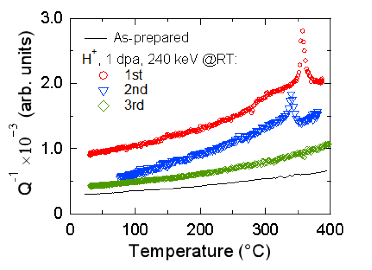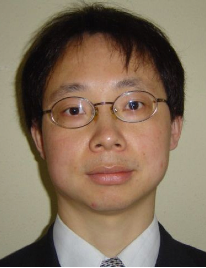Internal Friction Study on the Formation of Carbon-Vacancy Complexes Induced by Proton Irradiation in the RPV Steel
T. Hao 1*, X.Q. Liu 2, Q.F. Fang 2, X.B. Liu 3, Y.F. Li 3, F. Xue 3
1 Suzhou University of Sicence and Technology, Suzhou 215009, China
2 Institute of Solid State Physics, Chinese Academy of Sciences, Hefei 230031, China
3 Suzhou Nuclear Power Research Institute, Suzhou 215004, China
EXTENDED ABSTRACT: Irradiation-induced matrix damages (MD) and MnNiSi-enriched precipitates (MNPs) are the main cause of irradiation hardening/embrittlement in low-copper reactor pressure vessel (RPV) steel [1]. In this work, the Chinese-type RPV steel specimens were prepared for performing a proton irradiation experiment (H+, 1 dpa, 240 keV at room temperature) and the internal friction (IF) measurements. The IF measurement results show that there are no any IF peaks for the as-prepared RPV steel without proton irradiation, while an evident IF relaxation peak appears at 357 °C during the first heating, and shifts towards 340 °C in the second heating, and eventually disappears after the third heating. According to the IF experimental results for the cold-worked Fe-C alloys [2] and the density functional theory calculations for metastable Fe-C alloys [3], this IF relaxation peak can be assigned to be the dissolution of a carbon-vacancy complex composing of four carbon atoms and two vacancies (C4V2) which were produced at the early stage of MD under the proton irradiation. The shift of the IF peak towards low temperature in the second heating can be attributed to the dissolution of C4V2 to a metastable carbon-vacancy complex, and it is eventually discomposed of interstitial carbon atoms and vacancies after the third heating. The reason of only C4V2 formation rather than other type carbon-vacancy complexes will be discussed as well.

Figure 1. The internal friction curves for the as-prepared and the proton-irradiated Chinese-type RPV steel with three temperature sweeps.
REFERENCES
[1] M. shimodaira, T. Toyama, K. Yoshida, et al., Acta Mater., 155 (2018) 402–409.
[2] M. Konstantinović and L. Malerba. Phy. Rev. Mater., 1 (2017) 053602.
[3] C. Först, J. Slycke, K. Vliet, et al., Phys. Rev. Lett., 96 (2006) 175501.

Prof. Ting Hao gained his PhD in 2004 from the University of Tsukuba, Japan. Now he is a professor of the Suzhou University of Science and Technology, China. He has been working on metal materials and nuclear materials for more than ten years and has published more than 40 papers in reputed journals.